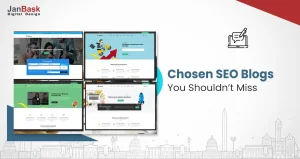
You may wonder why certain websites reach the top on Google, while others remain stuck on page 3 (or worse).
It's not luck; it’s intelligent, persistent SEO strategies.
Ranking highly in search engines is the key to visibility and credibility in today's busy digital landscape, regardless of whether you're a sole proprietor with a small business, the owner of a successful e-commerce brand on the rise, or the fresh face of your blog.
But with so much advice (and so much myth-making) in the air, where do you begin?
This blog will guide you through the most effective, time-tested, and newbie-friendly SEO tips to enhance your website’s ranking step by step. By the end of it, you won't just be an SEO expert, you'll also be equipped with actionable advice on how to use it to achieve actual results.
Let's get started.
Think of SEO like building a house:
These pillars help your site be viewed and ranked by search engines and complement each other to some extent. Treating one and neglecting the others will always constrain your outcomes.
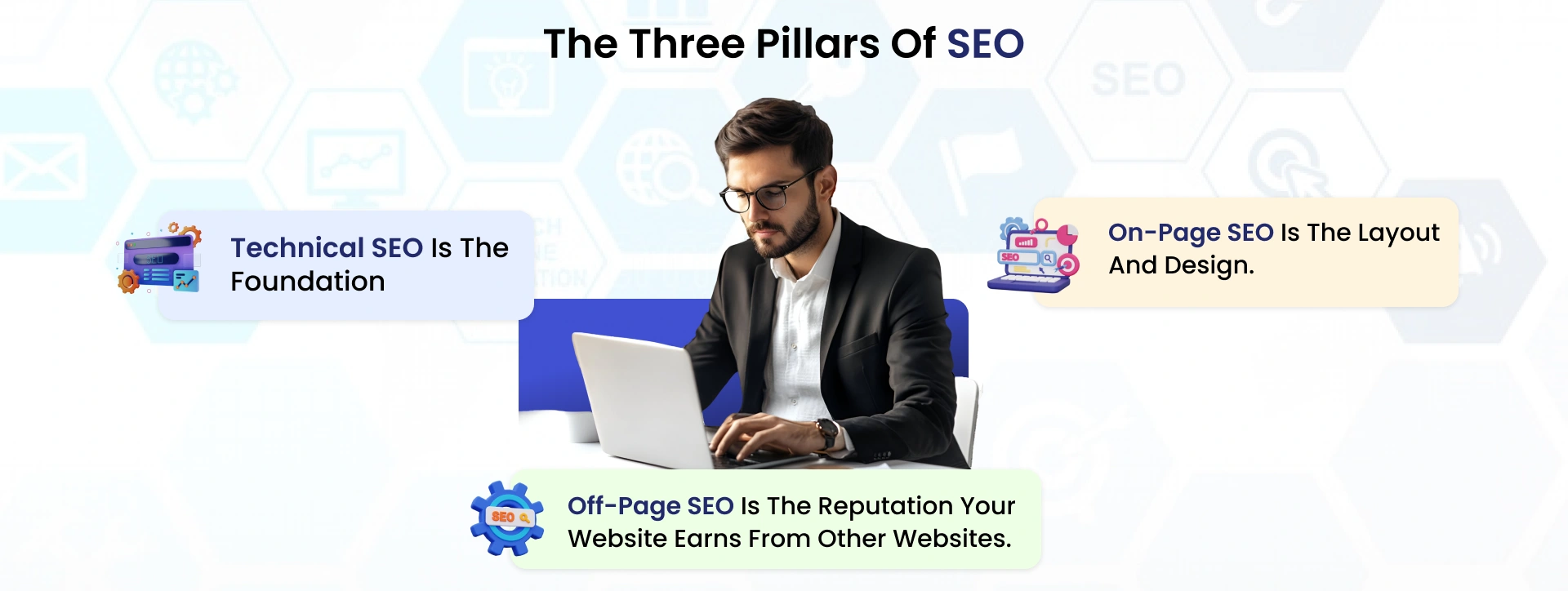
Let’s start with a simple idea: search engines like Google want to show users the best websites. But before they can do that, they need to find your site, understand it, and trust that it works well. That’s what technical SEO helps with.
Technical SEO is the behind-the-scenes setup that makes your website easy for search engines to crawl, index, and rank. Think of it like preparing a house before inviting guests. You clean up, make sure the lights work, organize the rooms, and make it easy to get around. If search engines show up and find a mess, they’ll leave without even checking out your content, no matter how good it is.
Here’s a breakdown of what technical SEO includes and how each part works to improve your rankings.
Search engines need to crawl before your website appears in search results. This process is called crawling. After crawling, they decide which pages to save and show to users. That’s called indexing.
To help with this, you’ll want to create an XML sitemap, a simple file listing all your site's essential pages. This acts like a roadmap, helping Google find everything it wants to see.
There’s also a file called robots.txt. This tells search engines which pages they should visit or not. For example, if you have private admin pages, you can block those from being crawled.
If you skip this step, Google might miss your most valuable pages or waste time crawling the wrong parts of your site. That can hurt your chances of showing up in search results.
Security is another signal Google uses when deciding where to rank your site. That’s why your website should use HTTPS, a secure web version.
HTTPS protects data that users send through your site, such as login details or contact forms. You’ll know a site is secure if there’s a little lock icon in the browser address bar.
Switching to HTTPS isn’t hard. You just need to get an SSL certificate from your hosting provider. Most offer it for free these days.
Besides protecting your visitors, HTTPS makes your site look more trustworthy and professional. And yes, it can also help your SEO.
Your website should be easy to navigate, not just for humans but also for search engines.
That starts with having a simple structure. Your homepage should link to your main pages, such as About, Services, and Blog, and those pages should link to more detailed content. Every page should be just a few clicks away from your homepage.
Also, your URLs should be short and easy to remember. For example, use something like yourwebsite.com/seo-tips instead of yourwebsite.com/page?id=1234.
You can also use internal links to guide visitors to related pages on your site. This not only keeps people browsing longer, but it also helps search engines understand the connection between your pages.
This makes it easier for Google to find and rank your most important content.
Structured data, also known as schema markup, is extra code you add to your pages to tell search engines more about what’s on them. For example, if you write a recipe blog, you can use schema to show ingredients, cook time, and reviews.
When you use structured data correctly, Google may reward you with rich results, such as extra information like star ratings, FAQs, or event details that appear in search. These can make your listings stand out and increase clicks.
You don’t need to be a developer to add schema; some plugins and generators can help you get started.
On-Page SEO is all about what’s happening on your website the stuff that both people and search engines can see. It's how you present your content, how you organize it, and how you communicate what each page is about. Think of it like setting up a shop: the way you display your products, write labels, organize shelves, and decorate the space can all influence whether people come in and stay, or leave.
Search engines pay close attention to how your site looks and reads. So, when your pages are clear, relevant, and engaging, you’re giving them all the right signals to rank you higher.
Let's learn about parts of On-Page SEO and why they matter.
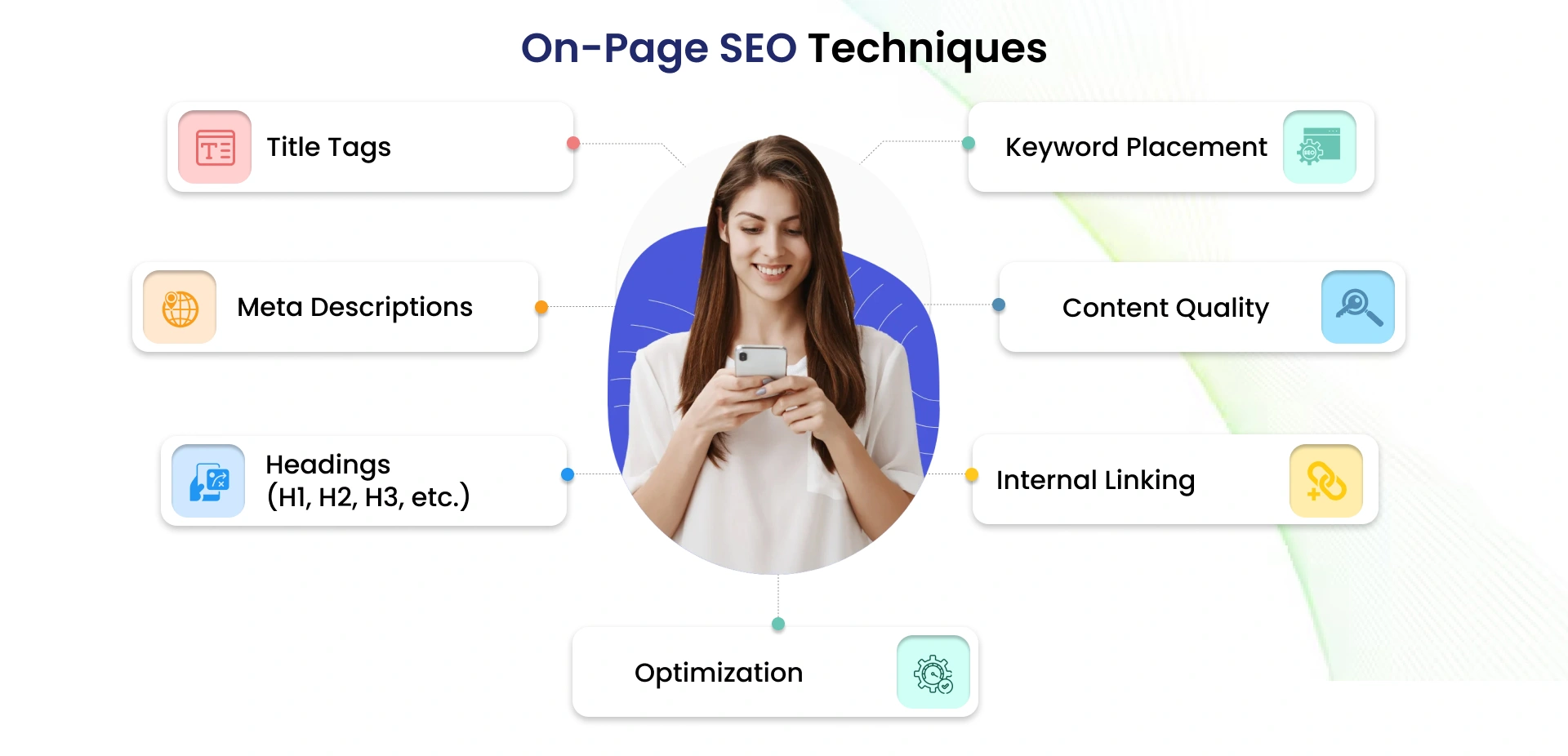
The title of your page, which appears in Google search results, is significant. It should clearly state what the page is about and include the main keyword someone might type in.
Good titles catch attention and make people want to click, and the more people click, the better your chances of ranking even higher.
This is the brief description that appears under your title in search results. While it doesn’t directly affect your ranking, it can boost your click-through rate. It’s your chance to tell someone, “Here’s why this page is worth your time.” Keep it short, clear, and helpful - just a quick preview of what someone will learn or gain from your page.
Headings help break your content into easy-to-digest chunks, like chapters in a book. Your main heading (H1) is the title of the page. Then, you use H2s and H3s for subtopics. It makes the page easier to skim, which both readers and search engines love. When your content is well-organized, it’s much easier to understand and rank.
Keywords are the words people type into Google. You want them to appear naturally throughout your page, especially in the title, headings, opening paragraphs, and possibly in image alt text as well. But don’t overdo it. Stuffing your content with the exact phrase over and over hurts more than it helps. Just aim to sound helpful and human, and sprinkle keywords where they make sense.
Your content needs to be helpful, original, and easy to understand. Don’t just write to fill space. Think about what your readers want to know and answer their questions clearly and concisely. The more valuable and engaging your content is, the more time people will spend on your site, which tells search engines that your page is worth ranking.
Linking to other pages on your site helps guide visitors to more information and keeps them engaged longer. It also helps search engines understand the site's structure. For example, if you have a page about SEO tools and another about SEO strategy, it makes total sense to connect them.
Images can make your content more interesting, but they also need to load quickly. Compress large files to prevent them from slowing down your site, and always add descriptive "alt" text. This helps with accessibility and provides search engines with more context about your content.
Think of Off-Page SEO as your website's reputation in the vast digital world. While On-Page SEO focuses on optimizing elements within your website, Off-Page SEO is about how others perceive your site online. It's like word of mouth for your website; when other reputable sites talk about you, it signals to search engines that your content is trustworthy and valuable.

Backlinks are links from other websites that point to your site. They're like endorsements; when a reputable site links to your content, it tells search engines that it is credible and worth referencing. How to earn backlinks:
While social media signals don't directly affect search rankings, they can help increase your content's visibility. When your content is shared widely, it reaches a broader audience, increasing the chances of earning backlinks.
For businesses targeting local audiences, it is crucial to ensure your business is listed accurately across various online directories. Consistent Name, Address, and Phone Number (NAP) information helps search engines verify your business's legitimacy.
Off-page SEO signals to search engines that your website is a trusted authority in your field. When multiple reputable sources reference or link to your content, search engines interpret this as a vote of confidence, which can lead to higher rankings in search results. Additionally, increased visibility through social media and influencer collaborations can increase traffic to your website, further boosting its authority and relevance.
To rank, you need to understand how Google finds and evaluates content. Once you see how the process works, it becomes obvious why every piece of your SEO strategy — from technical fixes to content structure — matters so much.

Google uses automated robots, also known as spiders, to crawl the web and identify new and updated pages. These robots quickly crawl from one page to the next to map out your site. Your site may be skipped over or missed if it loads slowly, is plagued by errors, or is poorly organized.
Links that are not linking properly, are situated too far down in your navigation, or are being blocked by robots may never be found.
This is most critical in technical SEO. A fresh, clean, and properly organized site clears those unseen hurdles and allows Google to access every significant page easily. This is foundational when exploring what are SEO strategies in the context of crawlability.
Once the page has been crawled, Google attempts to understand what it is about, a process called indexing. Consider it a giant digital library: indexing is the process by which your material is filed and stored in the correct section where it belongs.
The more straightforward you write in structure and organization, subject matter, and intent, the greater the chance you will be indexed correctly. This contrasts with vague and disorganized writing that may not be indexed or indexed improperly.
Indexing isn't always immediate. It may take days or weeks, depending on factors such as internal linking, site crawl health, and your site's overall authority. You can use Google Search Console's "URL Inspection" and "Coverage" tools to check what pages (and what is not) are indexed. These tools are free and designed precisely with that in mind.
When a person enters a search into Google, the search engine does not search the live web; it searches its index. It rapidly sifts through billions of stored web pages and ranks them based on hundreds of signals, including relevance, authority, freshness, speed, user experience, etc. This is where all you’ve accomplished, content excellence, organization, credibility, and technical competence.
A clean, reliable page that directly answers the user's query has a far higher chance of being ranked higher than a disorganized, slow-loading, and perplexing one. Innovative SEO tactics ensure every ranking signal is optimized for maximum performance.
Google doesn't simply refresh its algorithm once or twice per year; it tweaks it thousands of times yearly. These tweaks are usually minor and hardly perceptible. Occasionally, however, a significant change is introduced that radically reshapes the search landscape.
Of late, these larger rollouts have focused more on actual expertise, unique and valuable content, website speed, and overall user experience. Google is also improving at detecting low-effort, artificially generated content, authenticating legitimate authority, and excluding spammy websites.
We've seen it ourselves: websites that dominated the front page of results fell in visibility practically overnight following a core update, particularly those that contain thin content, outdated data, or copy written to get ranked rather than to help.

SEO is no longer about deceiving the algorithm. It's about being in tune with actual users' needs: fast, reliable, helpful information, and showing Google that you’re the go-to destination. This is the core of what our SEO strategies are meant to achieve.
The most intelligent method of staying ahead of algorithm changes is not to pursue every rumor or respond to every news headline. It is to create an SEO base that remains firm regardless of changing rules, a foundation built on solid SEO marketing plans.
Design beneficial content that answers questions and fixes problems. Use plain and concise language. Organize your pages effectively. Ensure that everything loads quickly, works seamlessly on mobile devices, and is easy to navigate.
Also, prioritize trust: earn natural backlinks, cite reliable sources, and write with a distinct voice and authority behind it. Proving to users and search engines that you're valuable and dependable will make you much less likely to be upset by an algorithm change. As long as you put people first and never cut corners, Google will trust you, even as the company evolves.
Google now prioritizes your mobile site over your desktop site. Mobile SEO is no longer a secondary activity; it is now the primary stage. To compete in today's market, your mobile experience should be snappy, accurate, and optimized for maximum search visibility and usability.
Google typically uses your site's mobile version to determine where and how you rank in search results. This mobile-first indexing mirrors how most users interact with the internet on their mobile devices.

If your site is slow to load, breaks on smaller devices, or is difficult to use with one thumb, you're behind even if your desktop site is perfect.
Mobile-first indexing is no longer a trend; it's the baseline. These days, your mobile site is your primary site for competing in search. Google examines that site first, and your users engage with it the most.
Optimizing mobile SEO is more than simply resizing a page. Your mobile user experience also needs to be smooth and intuitive. Use large tap targets, a clear text format, and scroll content. Also, keep in-page pop-ups to a minimum.

Also critical is page speed. Mobile users want websites to load in under three seconds; anything slower, and you'll lose visitors and rankings. That's where Core Web Vitals helps. Google has started using measures such as Largest Contentful Paint (LCP), First Input Delay (FID), and Cumulative Layout Shift (CLS) to evaluate actual performance, particularly on mobile devices. Falling behind on these metrics can silently hinder your ranks.
Also, structured data becomes even more significant in mobile search. When screen space is constrained, schema markup brings your content to the forefront in rich snippets, such as FAQs, reviews, and product details, right in the search results.
Is your site mobile-friendly? Use Google's Mobile-Friendly Test and PageSpeed Insights to verify exactly how your pages load and where you can improve.
Refine these mobile-specific sections with care, and you'll rise through the ranks and enhance the experience. This will keep visitors on the site, which in turn fuels even greater SEO outcomes.
SEO is time-consuming but brings long-term value. This part of the process demystifies what you can expect in your initial few months, what growth will look like, and how to track it. You're repairing a broken site or starting from scratch – either way, having a timeframe in mind helps you stay patient, consistent, and focused on what matters, delivering results.
Search Engine Optimization (SEO) is placing your brand in the precise moment that your audience is looking for solutions, acquiring intent-driven traffic at zero recurring cost of paid media.
Today, organic search visibility directly impacts:
Where website visibility is equivalent to market share, a robust SEO strategy is not a nicety; it's a boardroom necessity.
One of the most common SEO mistakes is expecting instant gratification.
Knowing the general timelines allows you to set smart goals, maintain focus, and not be discouraged. SEO growth is layered in that some wins may be quick to notice, yet the most valuable gains require time and persistent effort. When implementing practical search engine optimization approaches, it's important to remember that progress takes time.
As your strategy plays out, it’s key to monitor what’s working. Use Google Search Console to monitor search visibility and keyword ranks, and GA4 to monitor traffic quality, engagement, and conversions over time. SEO initiatives are not just about implementation but also continuous optimization.
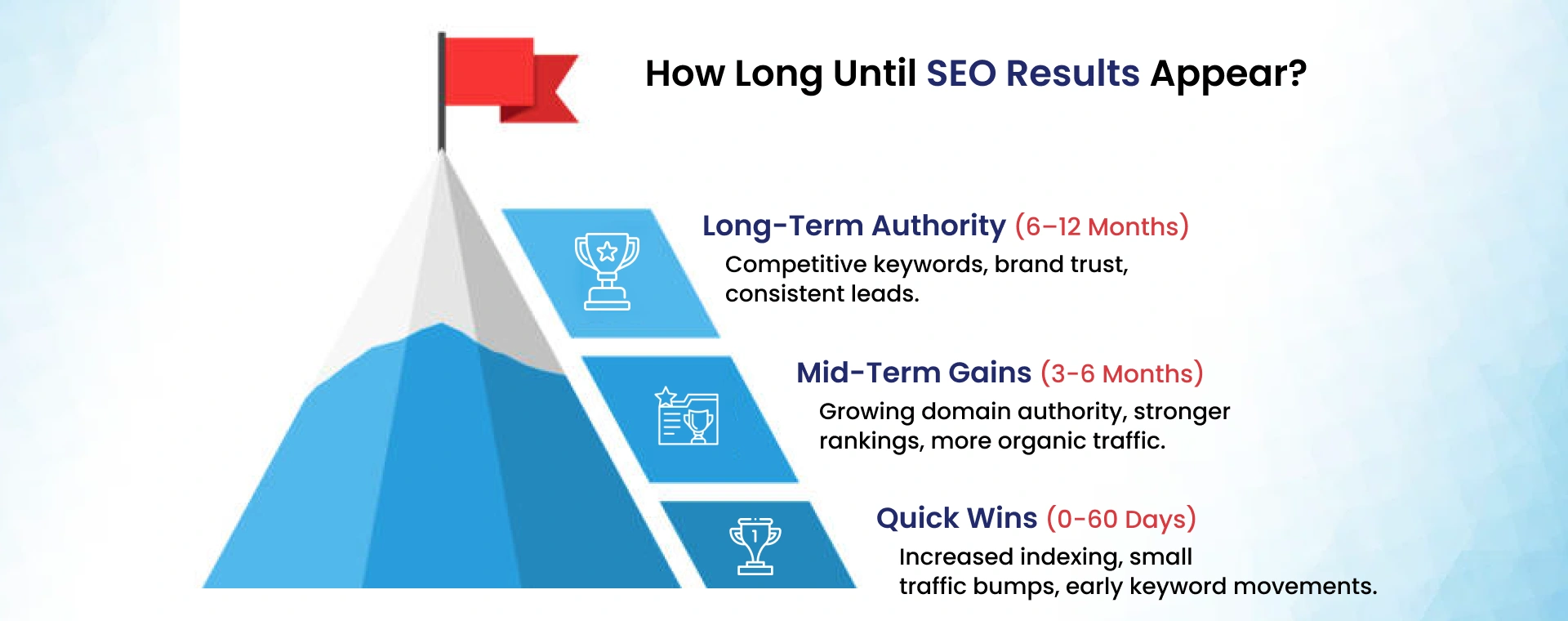
You may notice little heartening signs of improvement in the initial month or two, particularly if you’ve resolved significant technical problems, streamlined existing content, or launched appropriately targeted pages for low-competition keywords. This is the first step in understanding SEO strategies and how they impact your results early on.
Google usually takes days to weeks to crawl and reindex modifications. Throughout that time, slight bumps such as going from page 3 to page 2 are to be expected.
Don't expect massive traffic increases or peak ranks in this timeframe unless you're in a lightly competitive niche. However, these minor improvements serve as the foundation for SEO execution framework that will deliver greater results in the long term.
This is where persistent effort starts to reap benefits. Suppose you’ve been creating helpful content that is getting a few backlinks and working on improving your site’s technical health. In that case, you should see some tangible traction: keyword ranks improve, organic traffic increases, and visitors engage more substantially with your content. At this stage, you'll start seeing the effects of your SEO initiatives paying off.

Typically, it takes absolute SEO authority between six and twelve months, and longer in competitive niches. This is where you cease ranking for single keywords and instead dominate entire topics. You should notice increased growth in backlinks, click-throughs, and keyword coverage. Some of your pages may even begin to receive featured snippets.
The initial few months drag by. Still, once that authority accrues and compounds, it becomes tough to overtake new or less dedicated competition because you’ve created precisely the kind of trust and consistency Google wishes to bless with ranking. Your success here results from consistent search engine optimization actions and a firm SEO strategy roadmap that continues to drive your site’s performance.
Knowing SEO is step one. Knowledge cannot be converted to action without a plan. To compete and win in today's search conditions, you need cohesive SEO tactics that enhance your site's technical backbone and improve your content, credibility, and brand visibility.
At its core, your strategy answers three critical questions:
We'll guide you through the next section step by step, showing you how to create and implement a solid SEO marketing plan. This plan uses the same frameworks that industry-leading businesses use to drive search dominance and convert digital visibility into tangible business results.
Take a moment before opening a keyword tool or typing out a single headline and listen.
The most intelligent SEO begins with knowing your audience's genuine thoughts, challenges, and vocabulary. This is referred to as audience signal mapping, which is done by listening to actual conversations conducted on Reddit, Quora, YouTube comment sections, forums, and review websites. Let's look at the types of Google audience signals in the image below.
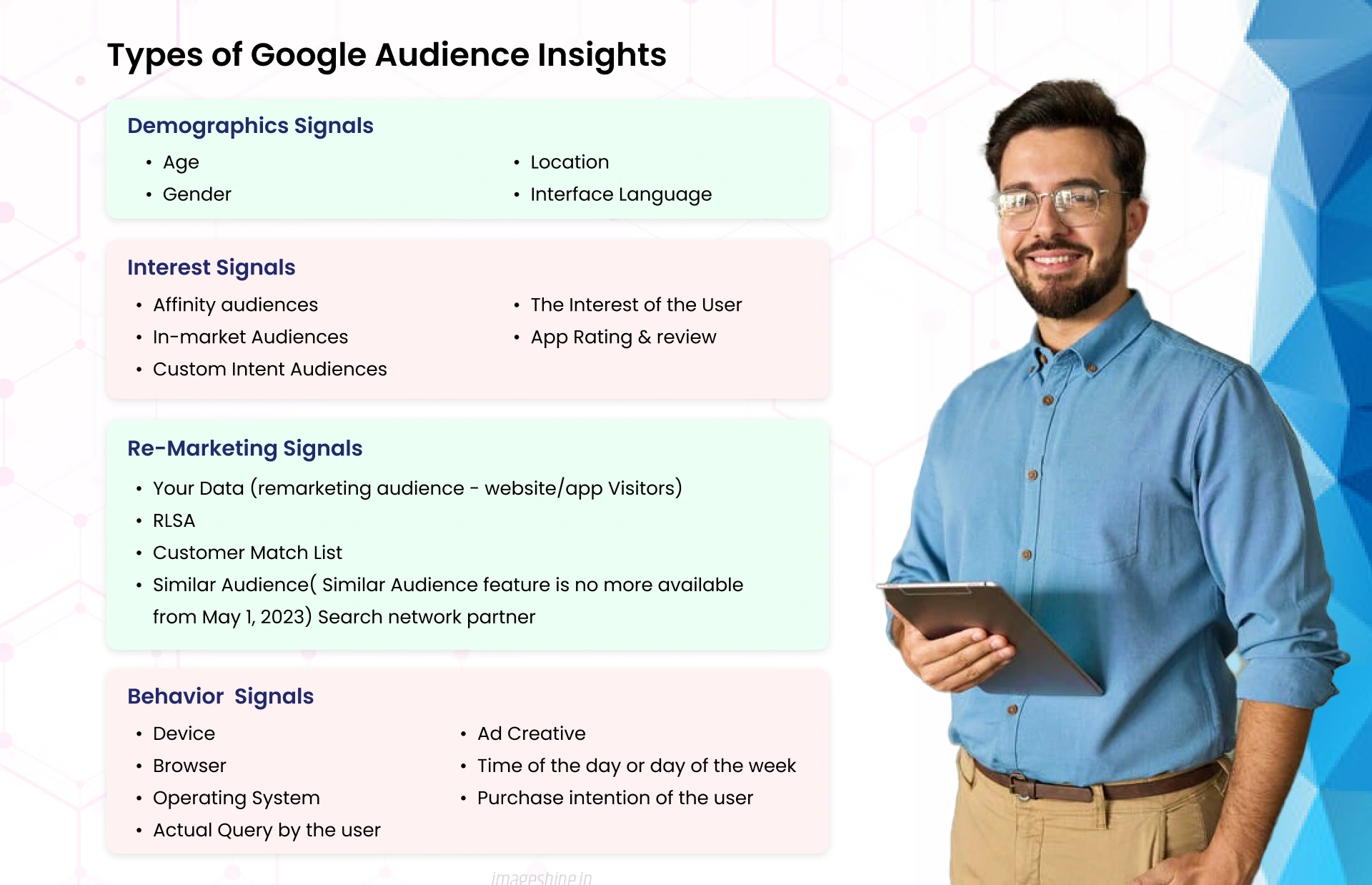
Your objective? Identify the patterns. What frustrates people? What problem do they want to solve? What words and phrases come to them most readily when describing their situation?
Hang out in these places, especially in threads related to your topic area. Pay attention to repeated questions, emotive vocabulary, and areas of confusion. These indicators tell you what your audience desires, usually before keyword tools do. These signals will also help you define the focus of your SEO strategies more precisely.
Once you've identified those signals, create copy that directly addresses them. Ditch the generic SEO copy. Begin with what humans are asking, and you'll be instantly noticed. This approach aligns directly with your SEO marketing tips, ensuring your content resonates with real user intent.
Not every visitor is ready to purchase, and Google knows this. Your copy must align with the user's intent, not just their keywords.
A person looking up “What is CRM?” is in learn mode. A person looking for the “best CRM for startups” is already in comparison mode. Intent matching is about creating a content pathway that aligns with users' minds, not where you want their minds to be.
Begin by creating a map of each step of the buyer journey:
Awareness: Introductory material such as “What is [X]?”, definitions, and FAQs
Consideration: Comparison guides, product listicles, and pros/cons breakdowns
Decision: Pricing pages, case studies, demo CTAs, and testimonials
When your website has content specific to every phase and internal linking that guides users through it, you don't just rank; you also engage. You build trust. You guide them. And by the time they're ready to move, they're sure you're the way to go.
Revenue-focused SEO ensures that all the content you create is connected to a business result, whether lead generation, getting onto demo calls, or closing deals. It turns your SEO away from chasing traffic and toward meaningful growth.

Utilize keyword research tools such as Semrush, Ahrefs, or Google Keyword Planner to determine the keywords that reflect buyer intent, that is, keywords with words such as “services,” “software,” “near me,” “for businesses,” and “pricing.” People search for these when they are closer to making a purchase decision. Google Search Console (GSC) shows how your website performs for its top 1,000 keywords in organic search.
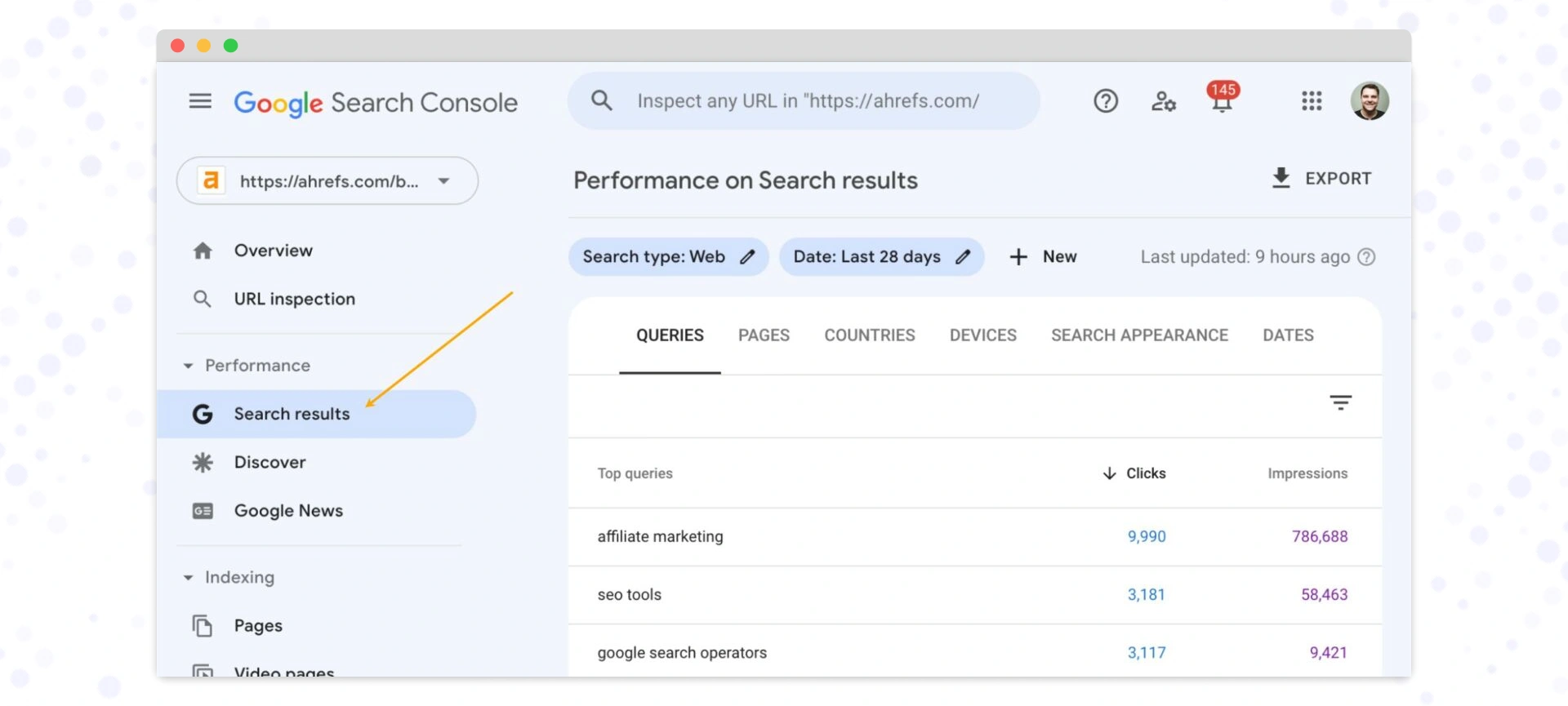
Develop your keyword strategy around high-intent keywords closely associated with your core products and/or services. That way, your search engine rankings attract visitors who are more likely to convert, not just surf.
Excellent writing doesn't win. After all, it was written once; it wins because it continues to improve. Compounding content quality means maintaining your highest-performing articles as long-term assets. Rather than constantly looking to create fresh blog posts weekly, plan periodic content reviews — best done every quarter — and refine what is working. This is integral to implementing search engine optimization techniques that ensure long-term success.
That may include freshening up stale statistics, introducing a new example, refining the introduction, or strengthening internal links to more recent pages. Even minor refreshes give Google a sign that you're publishing ongoing and reliable information.
Your content ranks longer, generates traffic over time, and saves you from constantly reinventing the wheel. These are innovative, scalable SEO marketing tips that focus on content optimization and longevity.
Google doesn't simply rank pages; it also ranks publishers that demonstrate authority over a topic. That's where topical authority comes in. Rather than having unrelated information scattered throughout your site, cluster it around ideas you want to be associated with your business. This is a critical component of SEO strategies that aim to build comprehensive and reliable authority within a given field.
Semrush’s Topic Research tool is a great starting point.

Begin by selecting one high-impact subject area. Segment it into reasonable subtopics. Create in-depth and valuable material on each of them. Finally, tie them all together so that users and search engines can easily navigate the entire discussion.
This format informs Google, “We're not scratching the surface; we're the authority on this topic.”
When that is conveyed clearly, your authority grows rapidly, and so does the effectiveness of your seo strategies.
Trust signal amplification means ensuring that your website consistently communicates credibility to users and search engines. This is a crucial part of SEO plans to improve site authority and credibility.
Start with the essentials: Every significant page should display the author's name, team or company credentials, updated contact information, and a clear privacy policy. If available, add visible trust badges, client logos, verified reviews, or certifications. These elements are often incorporated in effective SEO marketing plans to build trust with users and search engines.

To strengthen your credibility in Google’s eyes, align with their E-E-A-T principles — Experience, Expertise, Authoritativeness, and Trustworthiness. One simple but powerful move? Use author schema markup to identify who wrote or reviewed the content. This helps search engines understand that a real, qualified person stands behind what’s published, and that goes a long way in competitive spaces.
The more trust you build in these quiet, consistent ways, the more likely you are to rank well and to convert the traffic you earn.
SEO isn’t just about getting people to your site; it’s about what they do once they arrive. User experience is a critical aspect of SEO tactics focusing on engagement and interaction.
Experience-first content means making every page easy, straightforward, and comfortable. That means short paragraphs, visual breathing room, clear formatting, and mobile-friendly layouts. Speed matters; pages that are too slow frustrate users and quietly damage rankings. Before hitting publish, open the page on your phone. Does it load fast? Is the text readable? Can you scroll without effort?
If it feels smooth and satisfying to read, you’ve already done better than most, and Google takes notice when visitors stay longer and bounce less. This focus on experience is at the heart of solid SEO marketing plans prioritizing long-term engagement.
The most substantial rankings don’t always come from clever keyword use; they come from strong brand signals. Real brand-driven SEO is about building a name people search for directly, talk about, and trust. This type of SEO is a vital part of SEO plans that work on visibility and reputation.
When users Google your brand name or your content is linked and mentioned without your permission, these are powerful signals of authority. To build that kind of presence, go beyond your website. Pitch guest posts. Share thoughtful opinions on LinkedIn. Publish original data or stories. Collaborate with trusted industry voices.
Every time your brand appears in the right place, it strengthens, as do your rankings across the board. These efforts are essential in driving organic growth and sustained visibility as part of broader SEO marketing plans.
More and more searches now end before a user clicks, thanks to featured snippets, knowledge panels, and “People Also Ask” boxes. That’s where zero-click SEO comes in and why modern SEO strategies increasingly focus on visibility as much as clicks.
Structure your content to answer questions clearly and directly to show up in these spaces. Use simple, one-paragraph answers high up on the page, followed by deeper explanations. Pair this with schema markup, such as FAQ or How To schema, to help Google understand the structure and relevance of your content.
Understanding what SEO marketing strategy is also includes knowing how to gain visibility where clicks don’t happen, but impressions still influence trust and recognition. Even if users don’t click, your brand gets seen. That visibility builds familiarity, and familiarity builds trust, which often leads to clicks later.
SEO doesn’t live in a vacuum and doesn’t have to stay confined to your website. Effective seo marketing plans consider this by promoting content across platforms to extend its impact.
Cross-channel SEO activation means repurposing your best-performing content where your audience already spends time. For example, you could turn a blog post into a LinkedIn carousel, pull key insights into an email campaign, or rewrite a guide into a webinar or a short video.
The more your content travels across channels, the more backlinks, mentions, engagement, and brand visibility you generate, all of which feed back into your organic rankings. It’s not just about publishing smarter content; it’s about applying SEO initiatives that maximize the reach and performance of every asset.
Not all SEO advice is worth following. This section breaks down outdated tactics and common myths that can quietly harm your rankings so you can focus on what truly works.
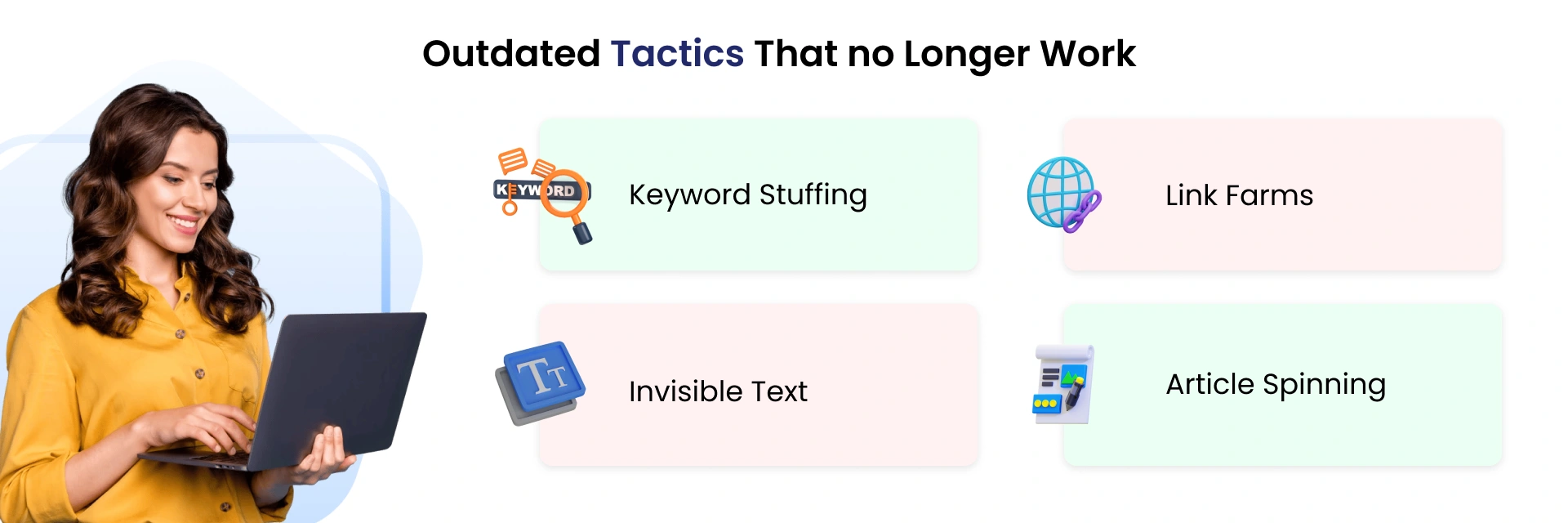
There was a time when SEO felt like a game of tricks. Stuffing keywords into every corner, buying bulk backlinks, or spinning low-quality content could boost rankings.
Today, not only do these tactics fail, but they can also actively harm you. Google’s algorithm is built to detect manipulation and reward real value. Shortcuts like keyword stuffing, thin guest posts, bloated link directories, or “SEO hacks” from a decade ago are no longer effective and may even trigger penalties.
If you’re still chasing quick wins, you’ll likely miss out on long-term growth. Modern SEO rewards clarity, quality, and user-first thinking, not gimmicks.
Even today, SEO is still full of bad advice. Let’s clear up a few of the most common myths:
Not quite. Length doesn't equal quality. What matters is whether your content clearly and thoroughly answers the search intent. A 600-word page can outperform a 3,000-word article if it gets straight to the point.
Nope. Google automatically discovers and indexes new content, especially if your site has clean internal links and a well-structured sitemap. Manual submission is rarely necessary.
Not anymore. Keyword stuffing makes content clunky and unreadable. Today, it's about using the right terms naturally and aligning your language with how real people search.
You don’t need a huge budget to succeed in SEO, but you need the right tools. Today's best platforms help you uncover smarter keywords, track rankings, monitor competitors, and fix issues before they cost you traffic.
To simplify things, here’s a breakdown of the top tools grouped by use case and who they’re best for.
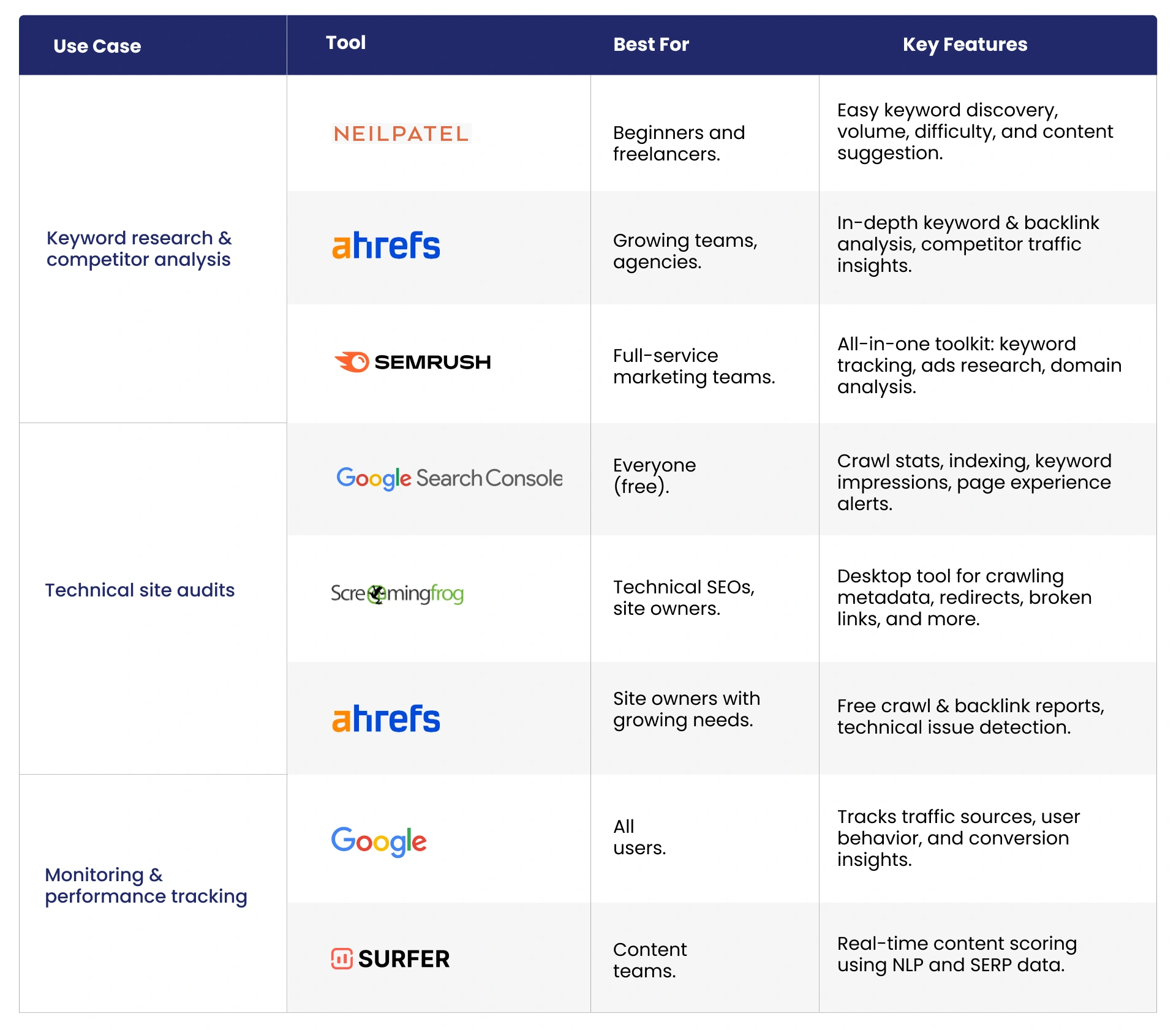
AI is changing how content is created, delivered, and ranked. This section shows how to use AI tools wisely, adapt to Google’s evolving search experience, and create content that still wins in a human-first world.
Search is evolving faster than ever, thanks to Google’s new AI-powered feature, Search Generative Experience (SGE).
Instead of just showing a list of links, Google now generates direct, conversational answers right on the search results page, often above the traditional search rankings.
This changes the game: your content isn’t just competing to be clicked; it’s competing to be quoted by Google’s AI. That means every piece needs to go deeper, be clearer, and offer more trustworthy context than ever before. Below is the pictorial representation of the Search with generative AI.
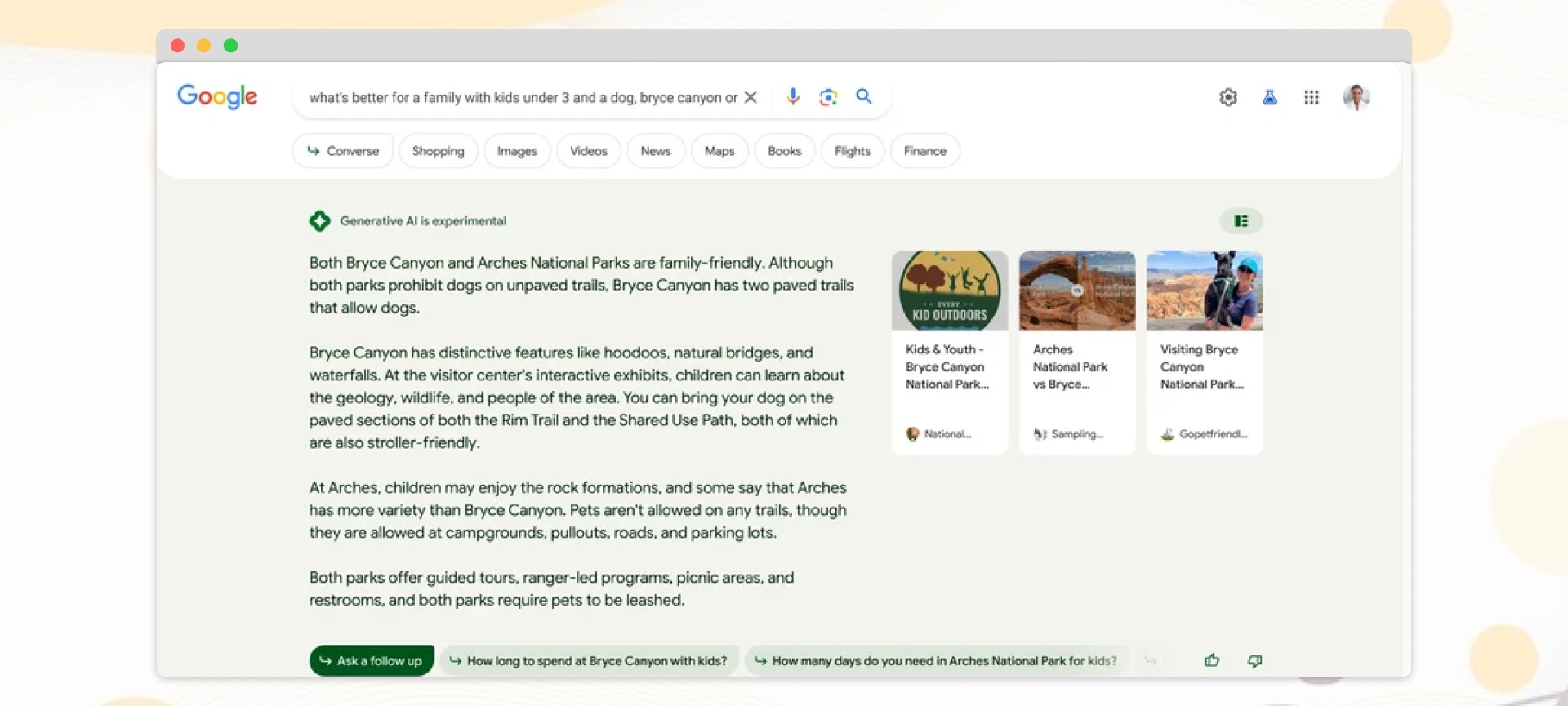
SGE rewards content that fully addresses the user’s search journey, not just by keywords, but by intent, structure, and clarity. To stay visible in this new environment, you’ll need to write content that is the best answer on the Internet, not just one of many.
AI tools can supercharge your workflow, but only if used with purpose.
Instead of having AI write your content for you, use tools like ChatGPT to brainstorm angles, outline your structure, or generate a list of questions your audience is already asking. This helps you move faster without compromising quality.
AI can also help analyze competitors, uncover keyword gaps, and reframe complex topics. But the final content, the voice, insights, and nuance should always come from you. That’s what sets your site apart in a crowded field.
No matter how advanced AI becomes, Google has made one thing clear: content written for people first will always win.
This is at the heart of the Helpful Content Update, which prioritizes original, trustworthy, and genuinely helpful material for readers, not written for algorithms.
You’ll also rank stronger when you follow Google’s E-E-A-T principles, demonstrating experience, expertise, authoritativeness, and trustworthiness. That means showing who wrote the content, backing up claims with objective evidence, and focusing on content that answers real-world questions.
Thin, generic, or purely AI-generated content will fade. The future belongs to content that sounds and feels human and solves human problems.
Let's be realistic for a moment.
You wouldn't use your internal accountant to design your building, and you wouldn't ask your office manager to write contracts. Why? Because some things demand specialized skills, and so does SEO.
You can read blogs, add keywords to your website, and even subscribe to SEO tools and software. However, actual SEO, which ranks you on page 1 of Google and brings you genuine leads, is a job in and of itself. It requires in-depth expertise, ongoing research, innovative strategies, technical adjustments, content mastery, and patience.
A professional SEO agency is where you come in. It's money well spent, to be sure:
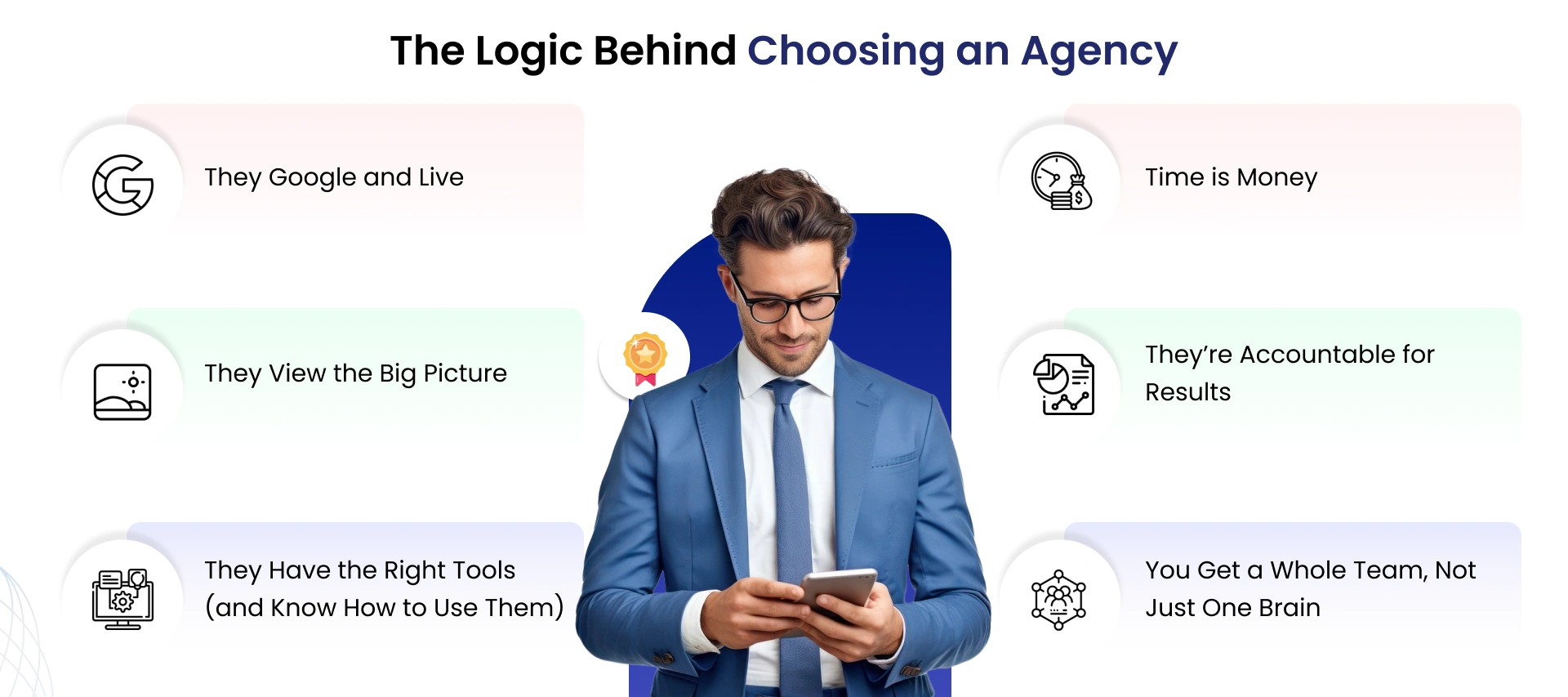
Google's algorithm is modified over 3,000 times per annum. Blink, and you've missed a significant update. Agencies remain current on every change, so you don't have to.
SEO is not about keyword stuffing alone. It affects your site structure, page speed, user experience, content quality, backlinks, local listings, mobile responsiveness, and more. Agencies consider it all.
Yes, those tools, such as SEMrush, Ahrefs, and Screaming Frog, are capable, but flying a spaceship is what they can be if you’re not sure what you’re doing. Agencies utilize those tools and understand how to convert the information into action.
You have a business to run. Spending 20 hours a week on SEO trial and error isn’t the best use of your time. An agency gets results faster and more efficiently while you focus on what you do best.
Good agencies don’t just make promises; they back them up with reports, rankings, traffic data, and clear deliverables. You’ll always know what’s working (and what’s not).
With an agency, you’re not hiring one person—you’re getting a team of specialists: strategists, content creators, technical experts, analysts, and link-building pros, all working together to grow your visibility. When comparing team vs freelancer setups, this collaborative model often ensures faster, more reliable results across the board.
SEO isn’t a one-time fix; it’s a long-term investment in visibility, credibility, and growth. The brands that consistently rank at the top aren’t lucky—they’re intentional. They invest in SEO services with purpose, update with discipline, and evolve with every algorithm shift. SEO rewards those who stay curious, keep testing, and continually align their strategy with real human value.
If you’re ready to turn search into a serious growth channel, JanBask Digital Design is here to help. We don’t just optimize pages; we help you build a brand that search engines trust and people love to engage with. Whether you need a strategy from scratch or want to take your existing strategy to the next level, let’s grow your visibility together.
Explore Proven Strategies to Improve Your SEO Ranking

I
I have gone through so many blogs on SEO optimization, but this is the best one.
K
Hi! I followed your SEO strategies and they were really helpful! I am glad for your article.
w
Fantastic article! Your step-by-step guide on crafting a powerful SEO strategy is incredibly helpful. The detailed breakdown makes it easy to understand and implement each step. Thanks for sharing such valuable insights!
d
Great post! I really enjoyed your insights — they were clear, practical, and inspiring. Looking forward to reading more from you. Keep up the amazing work!
A
Finally, an SEO blog that’s easy to understand and not full of fluff!
�
I followed just 3 tips and my blog traffic went up 35%. Great resource!